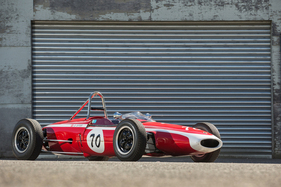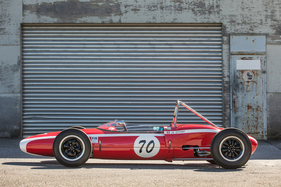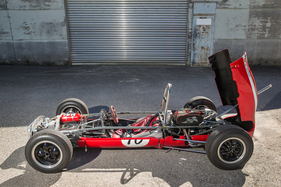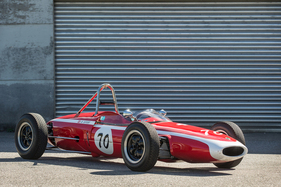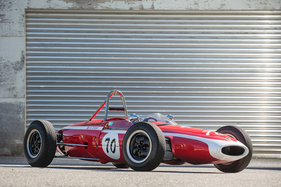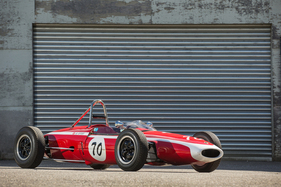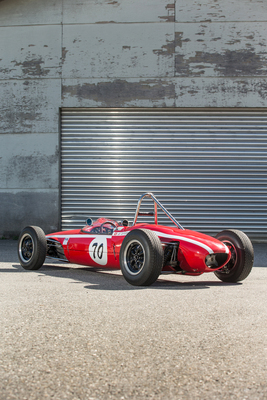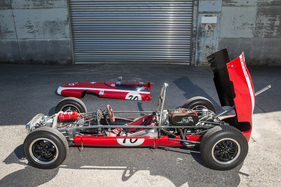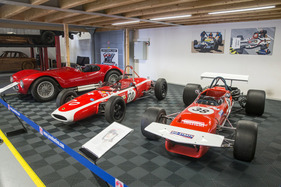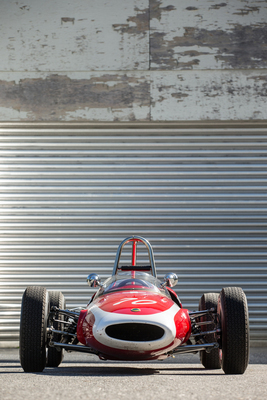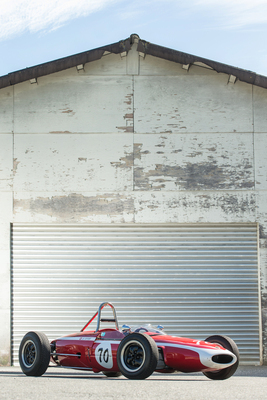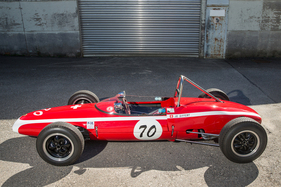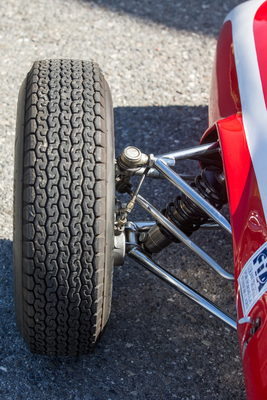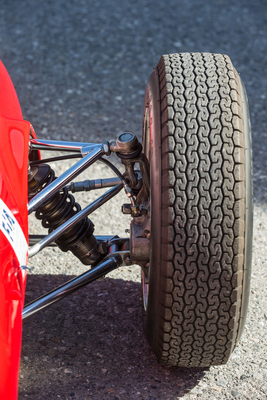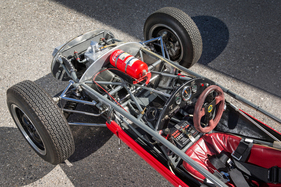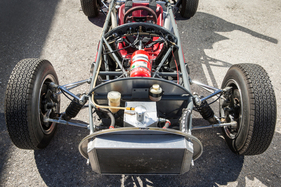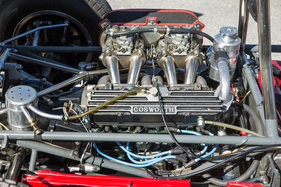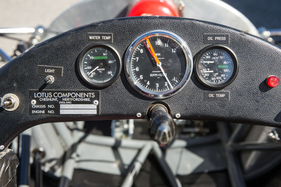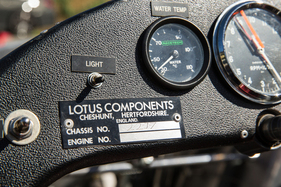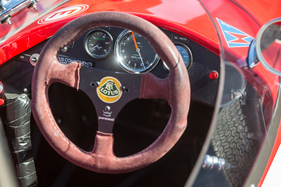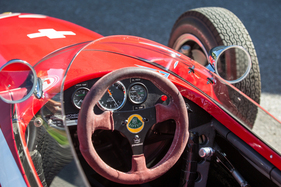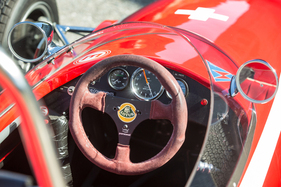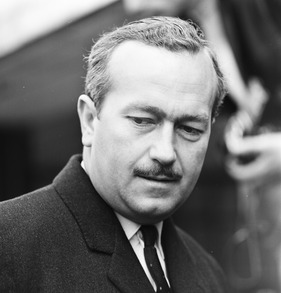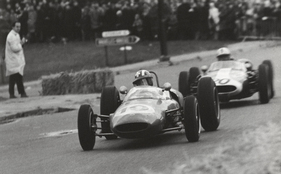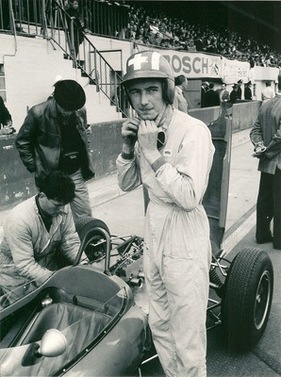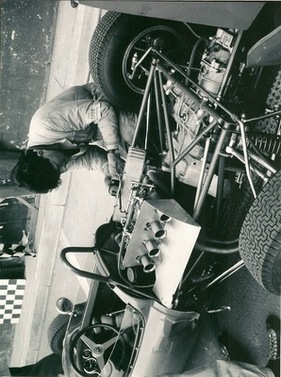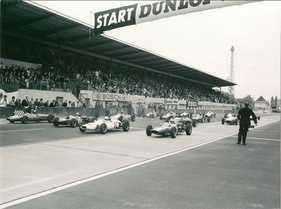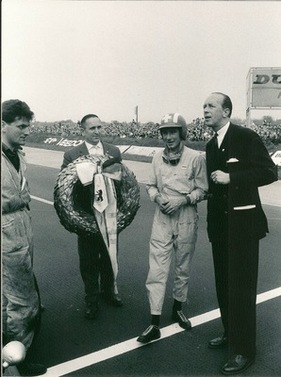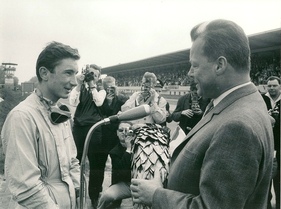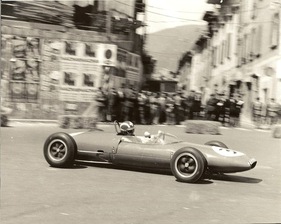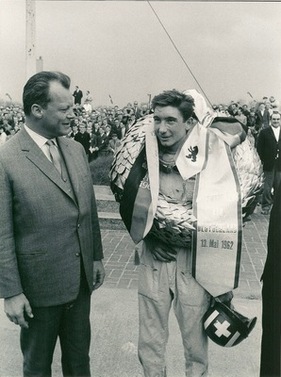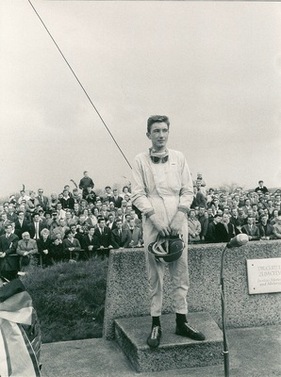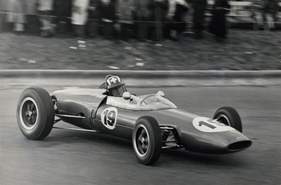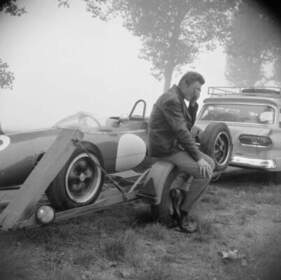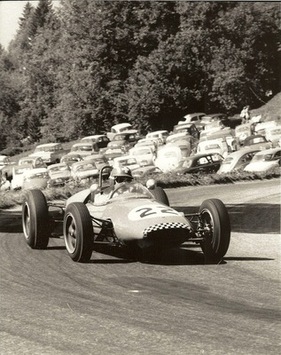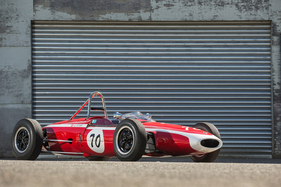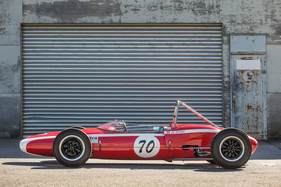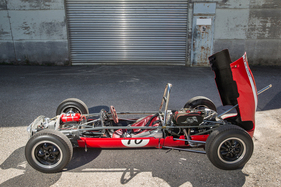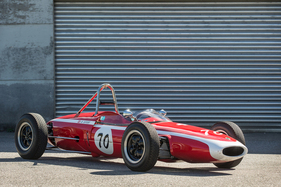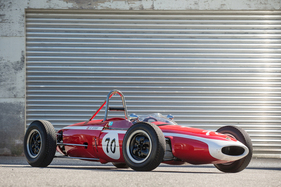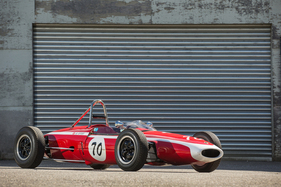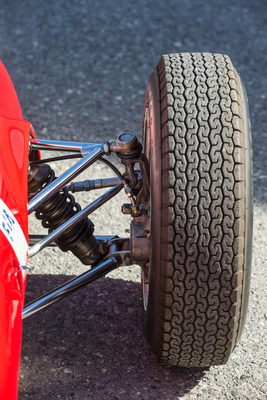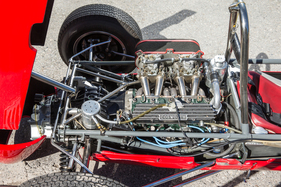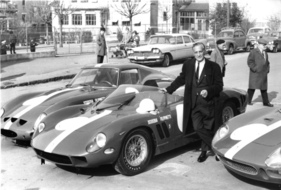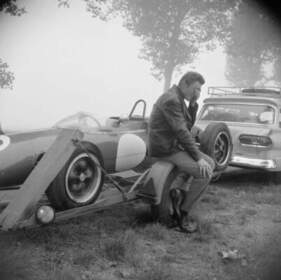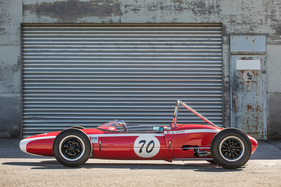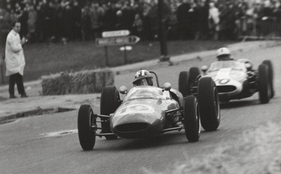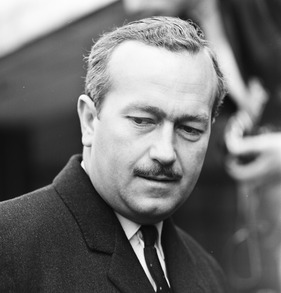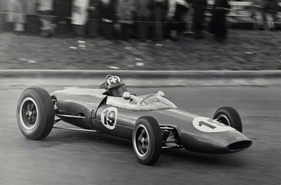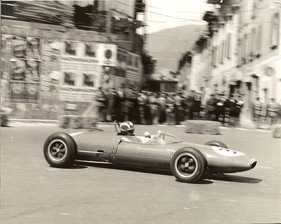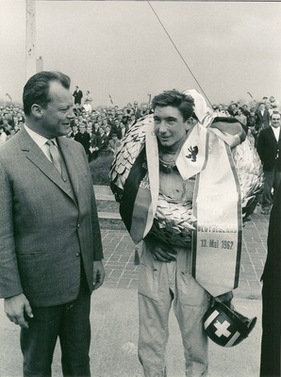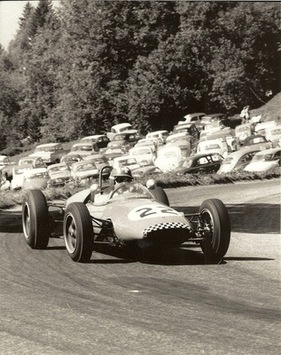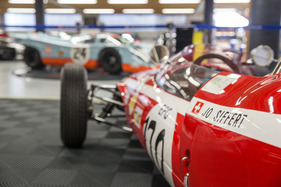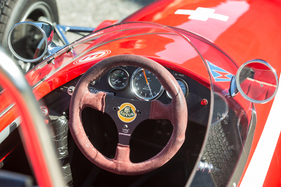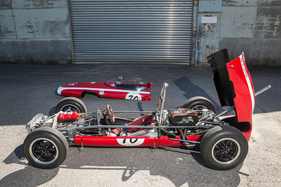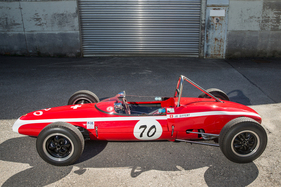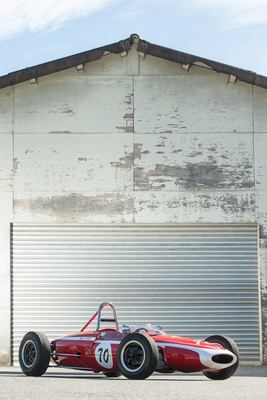The Lotus Type 22, a monoposto for use in Formula Junior, was presented at the "Racing Car Show" in London in January 1962, after which a total of 77 cars were built between 1962 and '65. In contrast to the Type 20 from the previous year, the 22 had a stiffer tubular frame with additional stabilizing elements. Typical of Lotus, the racing car, which was actually intended for an entry-level class, once again raised the bar considerably in terms of technology and handling. Apart from the engine and its displacement, there were in principle hardly any compromises to be made compared to higher racing classes.
One example: all four wheels in the typical Lotus "wobbly-web design" now had a diameter of 13 inches and were fitted with Girling disc brakes. The 1100 cc Ford-Cosworth engine, based on the Ford Kent, was fitted with dry sump lubrication and tilted to the right to keep the center of gravity low.
A certificate holder
The number 7 of these 77 cars built is an unparalleled witness to Swiss motorsport history. Jo Siffert, usually just called "Seppi", drove this Lotus 22 in 1962 for the Swiss national team "Scuderia Filipinetti", which was founded on March 13, 1962 by Geneva entrepreneur and motorsport enthusiast Georges Filipinetti. This was actually a win-win situation, because Filipinetti had been persuaded to found the team in the first place at the great request of journalist and friend Henri-Francois Berchet, who was so enthusiastic about Siffert's talent.
After Seppi had already proven his racing genes on two wheels, the Fribourg-born Siffert switched to a Lotus 18 and now four wheels in 1960 - after a brief interlude in a Stanguellini. In 1961, he proved his talent with the Lotus 20 and won the European Formula Junior Championship. Siffert, who had to save every last centime for racing, had finally arrived where he always saw himself in his dreams.
When he visited the Lotus factory in Cheshunt in the fall to receive his Formula Junior Championship trophy, he ordered the Lotus 22 shown here, chassis number 7, in the expectation that it would further his monoposto career.
At the same time, he gratefully accepted the help of Georges Filipinetti, who supported young Swiss drivers. Siffert signed a multi-year contract, and Filipinetti also immediately ordered a Formula 1 racing car: a Lotus 21. Although the intention was to enter this latest Lotus in an early, non-championship road race, the Brussels Grand Prix, the car - Lotus was a very busy company - was not ready in time.
Instead, Siffert's Lotus 22 with chassis number 22-J-7 was used, but equipped with a 1500 cc engine borrowed from Colin Chapman. It is believed that this is the only Lotus 22 that was homologated for Formula 1 competition.
The young team's first Formula 1 outing with Siffert was a success. The Swiss rookie challenged Stirling Moss at times and ended the weekend with a sixth place overall - an impeccable result - and a strengthened reputation among his new rivals.
Two weeks later, Siffert competed in the Vienna Grand Prix with his car, now once again equipped with the original 1100 cc engine. After his extremely brilliant Formula 1 debut in Brussels, Jo Siffert was able to celebrate his first Formula Junior victory at the Vienna-Aspern airfield. Father and son Ahrens had to admit defeat to the Fribourger in second and third place. And what's more: Seppi had lapped the entire competition at least once. Siffert was thus in remarkable form, and one could guess that the season that had just begun would still offer him many a success.
Indeed: further victories followed at the Circuito di Cesenatico in Italy and on the Avus in Germany. The Grand Prix of Nations for junior racing cars on the Avus was divided into two heats - one over ten and one over 15 laps - with the final classification being compiled from the results of both heats. In both races, nobody was a match for Jo Siffert in his Lotus.
The Swiss driver took his third win of the season ahead of the Austrian Bardi-Barry on Cooper and the German Kurt Ahrens Jr. on Cooper. Siffert also drove the fastest lap of the race with 2:36.9 minutes, which corresponds to an average speed of 190.4 km/h.
In August 1962, Seppi drove the Lotus 22 in his home country to win his class in the famous Ollon-Villars hill climb. It had not even been planned to enter the Formula Junior. However, with a time of 4:37.7 minutes, Siffert was faster than Charles Vögele in a Lotus 19 Monte Carlo with a 2.5-liter engine, Jim Clark in a Lotus 21 (from Scuderia Filipinetti!), Heini Walter in a Porsche RS 60 and so on. For this reason, the Freiburg driver's performance carries particular weight. Siffert had to start in the Filipinetti team's junior car because the F1 Lotus with an eight-cylinder BRM engine originally intended for Jim Clark had been destroyed in Enna, which is why the Englishman was given the Lotus 21 intended for Siffert by Scuderia Filipinetti.
For Jo Siffert and the Lotus 22, however, Ollon-Villars was their last appearance together, because Siffert wanted more: Formula 1 - understandably after his success in Formula Junior.
From the Lotus 22 to the Lotus 24
Shortly before the race in Pau (now for Formula 1), Jo Siffert received only a half-finished Lotus 24 from Colin Chapman. In addition, most of the components at the front and rear did not fit together. Some parts were even defective, such as the oil pump, which had to be replaced immediately. The engine was also not the intended engine, but a unit that had probably previously served as a test unit. After a day and a night of hard work by Seppi and his mechanics Piller, Oberson and "Bisule" (his nickname), the Lotus 24 was ready shortly before the end of practice, allowing Siffert to qualify for the race in the final minutes with just four practice laps.
In the race itself, Seppi again surprised everyone with his skillful style, but he was hampered by a broken gearshift linkage and had to finish the race in fourth gear. His sixth place is therefore more than honorable. However, Siffert could have finished at least one or two places higher with a perfect gearbox. At least he saved Chapman's honor and became the best Lotus driver after the double retirement of works drivers Clark and Taylor.
The following could be read about the Belgian GP in the Automobil Revue: "The Swiss looked forward to Jo Siffert's race with particular excitement. Alongside Lucien Bianchi (Lotus), he drove one of the only two English cars with a 4-cylinder Coventy-Climax engine. Siffert got the maximum possible out of his car and finished tenth with an overall average speed of 198.154 km/h. The Swiss driver constantly kept an eye on Trintignant, on whose drive he based his entire race. Unfortunately, he had to pit shortly before the end to refuel because they had made a mistake when calculating the fuel consumption. As a result, he lost a lap and ninth place, which then went to Bianchi."
And the following was written about the German GP at the Nürburgring: "Siffert's performance (12th place), who only had a 4-cylinder engine, deserves special mention. He was the second-best private driver in the final classification. Of the drivers with four-cylinder cars, only the South African Tony Maggs was ahead of the Swiss, who finished an astonishing 9th in last year's Cooper."
Unfortunately, the friendship between Siffert and the "Ecurie Filipinetti" broke down in Monte-Carlo in 1963 after various breakdowns, non-qualifications and no tangible results. Seppi bought his way out of the contract and immediately continued on his own.
The author has the following comment on this: "This was exactly the moment when the friendship with my father Josef Reinhard began. His failure to qualify again (18th place with only 16 starters admitted to the race) denied him the urgently needed entry fee to finance his journey home. My father then gave him the money to get back home - a gesture that Seppi never forgot."
The further history of 22-J-7
Documents in the Lotus 22's extensive accompanying dossier show that the car was part of racing driver Martin Hugi's fleet before it was acquired by its current owner Christian Traber. Chassis number 22-J-7 has belonged to the current owner since 1989. Articles about the car in Automobile Revue reveal that the car was fitted with a twin-cam Lotus engine at the time, which was later replaced by a correct 1.1-liter Cosworth unit. Under the current owner, however, the car was not a pure museum piece, although it was exhibited in many places, such as at the OTM in Fribourg in 2014 - on the Automobil Revue stand - and at events where Seppi's son Philippe Siffert - himself a well-known racing driver - was at the wheel.
A thorough, photographically documented restoration by Urban Fässler Racing from Hinwil shows how Siffert's Lotus was stripped down to the frame and thoroughly restored. The end result is impressive, as were the results on the race track! The Lotus has added to and extended its palmares in recent history at the Autodromo Internazionale del Mugello, the Pau circuit, Donington Park and the Nürburgring with further awards and trophies.
Invoices and documentation regarding regular maintenance by Fässler and the Graber sports garage are available for the uninterrupted, verifiable history of the car. This is not always a matter of course for a racing car.
Today, the Lotus 22 is perhaps in its best condition since the 1962 racing season, when it competed in Formula 1 and Formula Junior competitions.
The Lotus is also an ideal introduction to the highest levels of international historic competition. It comes with an FIA HTP that is valid until the end of 2025. From the "Chichester Cup" in Goodwood to events at local level, Jo Siffert's Lotus 22-J-7 will be a welcome guest everywhere and will ennoble every start list - a unique opportunity! The car will be offered for auction at Broad Arrow Auctions ' first auction on November 1, 2025 at the Dolder Grand Hotel in Zurich and is therefore waiting for a new custodian, a new guardian of this important piece of Swiss motorsport history.



